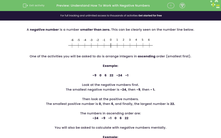Negative numbers aren't bad as the name might suggest. We just need to get to know them a bit more!
A negative number is a number smaller than zero. This can be clearly seen on the number line below.
When we are looking for the smallest negative number, it will be the one furthest down the number line away from zero.
So here, -6 is smaller than -2 because it's further away from zero and the positive numbers. It's a funny one to get your head around because when you're dealing with negative numbers, the bigger the number, the smaller it is.
One of the activities you will be asked to do is arrange integers in ascending order (smallest first).
Example:
-9 0 6 22 -24 -1
Look at the negative numbers first.
The smallest negative number is -24, then -9, then - 1.
Then look at the positive numbers.
The smallest positive number is 0, then 6, and finally, the largest number is 22.
So, the numbers in ascending order are:
-24 -9 -1 0 6 22
You will also be asked to calculate the difference between negative numbers.
Example:
The temperature on Monday morning is -4°C. The temperature on Friday morning is 1°C. How much warmer is it on Friday morning?

You may be able to do this type of calculation in your head but if not, a number line will always save the day! They're great because you can easily draw one out on a piece of paper any time you need it.
If we start on -4 and jump along the number line to 1, you can see we move 5 places.

Answer: 5°C
Grab your number line and let's go and practice questions.




(1).PNG)




